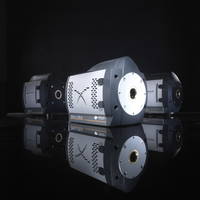Andor Cameras Help Detect Source of Laser Beam Attacks on Aircraft

Belfast, Northern Ireland, 12th August 2019 – Laser beam strikes on aircraft have long been a concern for aviation authorities across the world. In 2017, the Federal Aviation Administration in the United States received 6,754 individual reports of lasers being purposely aimed at their pilots, and in past week, five aircraft were targeted as they flew in to land at Glasgow Airport in Scotland. As well as the immense danger posed to human life, where a pilot potentially loses visibility of the approaching runway, the aiming of lasers at aircraft is illegal in many countries, with the threat of prosecution for those found guilty of the offence.
This has presented local and federal authorities with a challenge of identifying the origin of the strikes, with less than 1% of perpetrators in the US ever being tracked down. A team from MIT Lincoln Laboratory have been working on a ground-based solution that may provide an answer to this problem, helping to quickly identify the individuals involved and bring them to justice. The Laser Aircraft Strike Suppression Optical System (LASSOS), which features Andor’s highly sensitive iXon EMCCD cameras, is a ground-based sensor system that can accurately identify the origin of the strike and subsequently enable local law-enforcement to launch a rapid and targeted response.
When a laser is pointed into the sky, a small fraction of the light is scattered by molecules and aerosols in the air which forms a residual streak in the laser's path. The system works by using the EMCCD cameras to image the scattered light from different viewpoints, providing enough data to digitally reconstruct the laser streak in three dimensions. With the calculated coordinates of the laser’s origin, the team can instantly pinpoint the precise location of the strike on Google Earth for the response teams to engage and apprehend.
Although still in prototype, the LASSOS team, a collaboration between the Laser Technology and Applications and Air Traffic Control Systems groups at Lincoln Laboratory, believe the technology will “significantly increase laser strike origin detection and perpetrator apprehension”.
Speaking of the involvement of Andor, an Oxford Instruments company, in the project, Dr Andrew Dennis, Director of Product Management said “We are excited to be a small part of this critical project to make the skies safer. We look forward to further supporting the excellent Lincoln Laboratory team and wish them success as they aim to bring this system into production.”
For more information on the cameras being used to support this crucial endeavour, please visit: https://andor.oxinst.com/products/ixon-emccd-cameras.
References
(1) MIT News: http://news.mit.edu/2017/mit-lincoln-laboratory-lassos-sensors-defend-aircraft-against-laser-strikes-0928
(2) https://www.youtube.com/watch?v=AsGCRfmfs0c
Enquiries:
For further information please contact Jonathan Rice on +44 (0)28 9023 7126, email press@andor.com, or visit http://www.andor.com.
About Andor
Andor is a global leader in the pioneering and manufacturing of high performance scientific imaging cameras, spectroscopy solutions and microscopy systems for research and OEM markets. Andor has been innovating the photonics industry for over 20 years and continues to set the standard for high performance light measuring solutions, enabling its customers to break new ground by performing light measurements previously considered impossible. Andor’s digital cameras, are allowing scientists around the world to measure light down to a single photon and capture events occurring within 1 billionth of a second.
Andor now has over 400 staff across 16 offices worldwide, distributing products to over 10,000 customers in 55 countries. Andor’s products are used in a wide range of applications including medical research to further the understanding of heart disease, cancer and neuronal diseases such as Alzheimer’s and Parkinson’s disease. Andor also has applications for forensic science and astronomy. Through continuous dialogue with customers and strong teamwork, Andor continues to innovate ground-breaking products that improve the world in which we live.
About Oxford Instruments plc
Oxford Instruments designs, supplies and supports high-technology tools and systems with a focus on research and industrial applications. Innovation has been the driving force behind Oxford Instruments' growth and success for over 50 years, and its strategy is to effect the successful commercialisation of these ideas by bringing them to market in a timely and customer-focused fashion.
The first technology business to be spun out from Oxford University, Oxford Instruments is now a global company with over 2000 staff worldwide. Its objective is to be the leading provider of new generation tools and systems for the research and industrial sectors with a focus on nanotechnology. Its key market sectors include nano-fabrication and nano-materials. The company’s strategy is to expand the business into the life sciences arena, where nanotechnology and biotechnology intersect.
This involves the combination of core technologies in areas such as low temperature, high magnetic field and ultra high vacuum environments; Nuclear Magnetic ReMaranance; x-ray, electron, laser and optical based metrology; atomic force microscopy; optical imaging; advanced growth, deposition and etching.
Oxford Instruments aims to pursue responsible development and deeper understanding of our world through science and technology. Its products, expertise, and ideas address global issues such as energy, environment, security and health.



